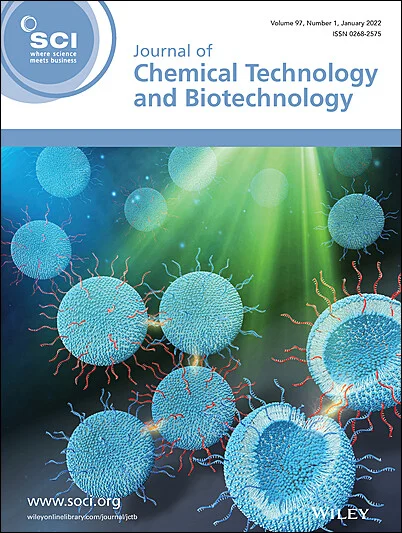求助PDF
{"title":"利用改性克林沸石超声转化木糖产生的甲酸和乳酸","authors":"Natalia Sobuś, Magdalena Król","doi":"10.1002/jctb.7721","DOIUrl":null,"url":null,"abstract":"<div>\n \n \n <section>\n \n <h3> BACKGROUND</h3>\n \n <p>A material of natural origin, clinoptilolite, was modified with selected metals in order to obtain a catalyst for the conversion of xylose – the main component of the hemicellulose fraction present in lignocellulosic biomass – to selected carboxylic acids.</p>\n </section>\n \n <section>\n \n <h3> RESULTS</h3>\n \n <p>The starting material without modification (0-parent), the hydrogen form (0-hydrogen) of zeolite and zeolite after hierarchization with hydrochloric acid (0-dealuminated) were used. Iron, copper and cobalt ions were introduced as active centers using the sonication technique. The catalytic process was carried out in a pressure autoclave for 2 h at a temperature of 220 °C. Compounds such as formic acid with a yield of 91% (0-parent) and lactic acid with a yield of 66.1% (Fe-hydrogen) were obtained.</p>\n </section>\n \n <section>\n \n <h3> Conclusion</h3>\n \n <p>The catalytic processes carried out using xylose lead to the obtaining of a mixture of carboxylic acids: lactic acid, pyruvic acid and formic acid. An important role here is played by the presence of iron as an active site, which leads to the transformation of xylose into lactic acid by dehydration, and the presence of Lewis and Brønsted active sites. In the case of formic acid, which has never been reported in publications on a similar topic, the starting zeolite without modification contributed to its preparation. It is possible that the content of alkali metals contributed to its preparation along with the coupling of the oxidation reaction of the intermediate product, because of the presence of small amounts of iron, which are present in the natural material. © 2024 Society of Chemical Industry (SCI).</p>\n </section>\n </div>","PeriodicalId":15335,"journal":{"name":"Journal of chemical technology and biotechnology","volume":"99 11","pages":"2326-2338"},"PeriodicalIF":2.8000,"publicationDate":"2024-08-02","publicationTypes":"Journal Article","fieldsOfStudy":null,"isOpenAccess":false,"openAccessPdf":"","citationCount":"0","resultStr":"{\"title\":\"Formic and lactic acids from the conversion of xylose with the use of modified clinoptilolite by sonication\",\"authors\":\"Natalia Sobuś, Magdalena Król\",\"doi\":\"10.1002/jctb.7721\",\"DOIUrl\":null,\"url\":null,\"abstract\":\"<div>\\n \\n \\n <section>\\n \\n <h3> BACKGROUND</h3>\\n \\n <p>A material of natural origin, clinoptilolite, was modified with selected metals in order to obtain a catalyst for the conversion of xylose – the main component of the hemicellulose fraction present in lignocellulosic biomass – to selected carboxylic acids.</p>\\n </section>\\n \\n <section>\\n \\n <h3> RESULTS</h3>\\n \\n <p>The starting material without modification (0-parent), the hydrogen form (0-hydrogen) of zeolite and zeolite after hierarchization with hydrochloric acid (0-dealuminated) were used. Iron, copper and cobalt ions were introduced as active centers using the sonication technique. The catalytic process was carried out in a pressure autoclave for 2 h at a temperature of 220 °C. Compounds such as formic acid with a yield of 91% (0-parent) and lactic acid with a yield of 66.1% (Fe-hydrogen) were obtained.</p>\\n </section>\\n \\n <section>\\n \\n <h3> Conclusion</h3>\\n \\n <p>The catalytic processes carried out using xylose lead to the obtaining of a mixture of carboxylic acids: lactic acid, pyruvic acid and formic acid. An important role here is played by the presence of iron as an active site, which leads to the transformation of xylose into lactic acid by dehydration, and the presence of Lewis and Brønsted active sites. In the case of formic acid, which has never been reported in publications on a similar topic, the starting zeolite without modification contributed to its preparation. It is possible that the content of alkali metals contributed to its preparation along with the coupling of the oxidation reaction of the intermediate product, because of the presence of small amounts of iron, which are present in the natural material. © 2024 Society of Chemical Industry (SCI).</p>\\n </section>\\n </div>\",\"PeriodicalId\":15335,\"journal\":{\"name\":\"Journal of chemical technology and biotechnology\",\"volume\":\"99 11\",\"pages\":\"2326-2338\"},\"PeriodicalIF\":2.8000,\"publicationDate\":\"2024-08-02\",\"publicationTypes\":\"Journal Article\",\"fieldsOfStudy\":null,\"isOpenAccess\":false,\"openAccessPdf\":\"\",\"citationCount\":\"0\",\"resultStr\":null,\"platform\":\"Semanticscholar\",\"paperid\":null,\"PeriodicalName\":\"Journal of chemical technology and biotechnology\",\"FirstCategoryId\":\"5\",\"ListUrlMain\":\"https://onlinelibrary.wiley.com/doi/10.1002/jctb.7721\",\"RegionNum\":4,\"RegionCategory\":\"生物学\",\"ArticlePicture\":[],\"TitleCN\":null,\"AbstractTextCN\":null,\"PMCID\":null,\"EPubDate\":\"\",\"PubModel\":\"\",\"JCR\":\"Q3\",\"JCRName\":\"BIOTECHNOLOGY & APPLIED MICROBIOLOGY\",\"Score\":null,\"Total\":0}","platform":"Semanticscholar","paperid":null,"PeriodicalName":"Journal of chemical technology and biotechnology","FirstCategoryId":"5","ListUrlMain":"https://onlinelibrary.wiley.com/doi/10.1002/jctb.7721","RegionNum":4,"RegionCategory":"生物学","ArticlePicture":[],"TitleCN":null,"AbstractTextCN":null,"PMCID":null,"EPubDate":"","PubModel":"","JCR":"Q3","JCRName":"BIOTECHNOLOGY & APPLIED MICROBIOLOGY","Score":null,"Total":0}
引用次数: 0
引用
批量引用

 求助内容:
求助内容: 应助结果提醒方式:
应助结果提醒方式:


